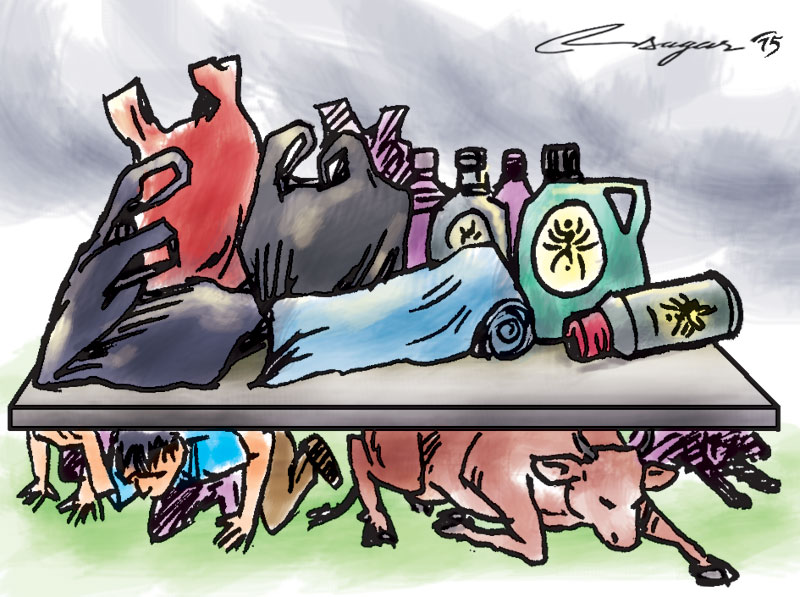Pesticides and plastic products: An emerging threat to life
Harmful food preservatives should be banned. Waste effluents from factories should not be diverted to river or to water bodies without treatment. Extensive use of commercial shampoo should be discouraged
Xeno-estrogens are synthetic substances that differ from those produced by living organism and imitate or enhance the effect of estrogens. The estrogenic stimulation is an unintended side effect of these agents or their metabolites. The field of xeno-hormones is new and has existed since 1991 only. These chemicals directly disrupt the endocrine system of the body and thereby affect the normal body functions.
The organs which are mostly at high risk are male and female reproductive systems although skeleton, thyroid, liver, kidney, and immune systems are also affected. Some of these substances like DDE, a metabolite of DDT, may persist in the body fat for decades.
There are apprehensions pointing towards the cumulative biochemical disruptions in genetic material that may even be transmitted through generations. Due to their extensive use, these chemicals have been polluting the environment globally for the last 50 years.
Pesticides were previously thought of as the source of xeno-estrogen. However, now many pharmaceuticals, chlorinated pesticides, polychlorinated biphenyls, and certain chemicals used in plastics and solvents have also been identified. In fact about 1,00,000 registered chemicals have hormone-like activity besides having toxic and carcinogenic effects. To exert any effect, hormones must first bind with specific proteins called receptors to form hormone-receptor complex which binds to DNA in a cell’s nucleus to activate specific genes.
Xeno-estrogens either occupy the receptor sites to prevent hormone binding or result in inappropriate activation of genes, causing reduction or improvement in cellular activity. This way they interfere with normal hormone function of the body. They may cause permanent or irreversible damage to the developing embryo and newborn and their sexual, physical or mental development may be arrested.
Pesticides, commercial and or domestic, include atrazine, alachlor, aldicarb, , benomyl, lindane, carbaryl, chlordane, cypermerthrin, and dicofol, among many. Heavy Metals include: Cadmium used in nickel, cadmium batteries, coating, pigments, stabilizers in plastics and synthetic products and alloys, fossil fuels; lead used in lead batteries, paints, pipes, leaded gasoline; and mercury used in nickel/ cadmium batteries fluorescent lighting ballasts, etc.
Organochlorines include: a) Dioxin, whose examples include incinerator emissions, and metal smelting; Polybrominatedbiphenyls and PCBs used in electrical transformers; and Pentachlorophenol wood preservative used in textile industry. Plastic ingredients and surface actants include: Bisphenol; Phthalates polycarbons; and Styrenes alky/nonyle phenol ethoxylates.
Xeno-estrogens enter the human body through food chain like meat milk eggs from animal origins as well as through green vegetables, contaminated water. In fatty tissue of animals these substances accumulate for decades. Contaminated water and vegetables containing pesticides are also responsible.
Plastic bottles containing drinking water and containers of various food items are an important source. The polycarbonate bottles used to hold drinking water have been found to contain Bisphenol-A of which 2-5 parts per billion have been found enough to cause breast cancer cells to proliferate. Preservatives methyl paraben used in skin lotion and gels are also weak estrogen. Alkyl hydroxyl benzoate preservatives like methyl-ethyl and butyleparaben are also weakly estrogenic and are able to compete with female hormone estradiol for binding to estrogen receptors. Subcutaneous administration of butyleparaben produces a positive estrogenic response on uterine tissues. Some of the baby shampoos contain about 50 times more than the daily adult dose of estradiol. A small amount of this shampoo on the child every day may result in the development of breast or pubic hair.
The chemical called Diethylhexylpthalate, which is used as plasticizer for PVC, may leach from the plastic into certain liquids. Prolonged exposure to the fluids in these bags may affect testicle development in young boys. The same effect they may exert in animals also which can be seen as an increase in infertility in domestic animals.
Considering the ubiquitous nature and severe multiple adverse effect of xeno-estrogen on human and animal life, the preventive measures need to be adapted are of utmost importance. In order to save the future generations, we have to be alert now.
Some of the vital measures to be adapted could be: a) Don’t use plastic items to store food and water. Glass or ceramics are preferable. b) Use simple detergent with fewer chemicals. c) Minimize the use of chemical pesticides.
Natural pest control measures like integrated pest management must be adapted. Use of hormone mimicking chemicals in consumer products should be stopped. Avoid using organo-chlorines in products like PVC plastics, dry cleaners. Use of sunscreen lotion, gels and other cosmetic items should be minimized. Natural oils as skin moisturizers should replace these items. Harmful food preservatives should be banned. Waste effluents from factories should not be diverted to river or to water bodies without treatment. Extensive use of commercial shampoo should be discouraged.






